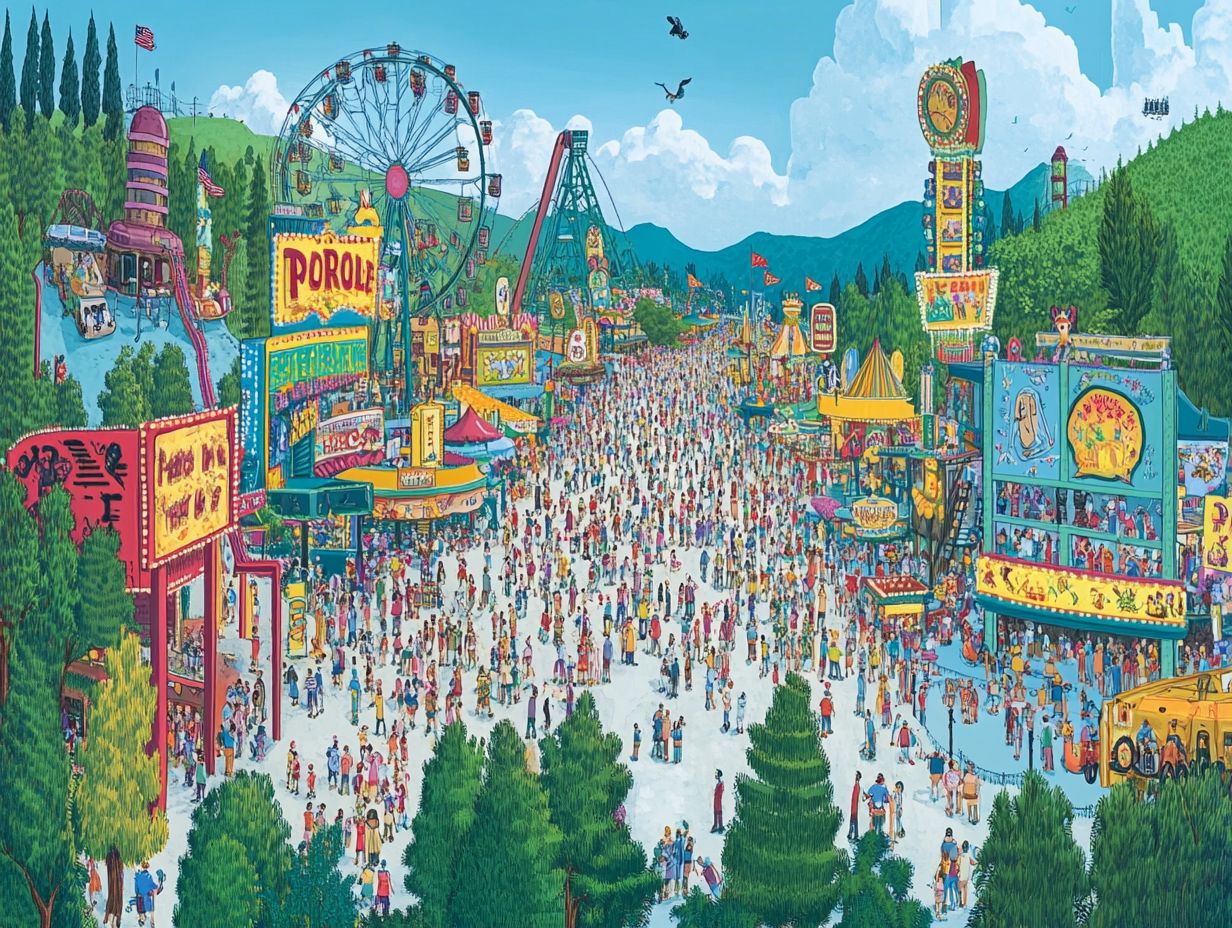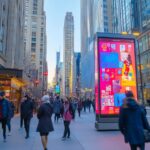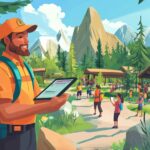In the realm of theme parks, long queues can transform a day of enjoyment into a frustrating experience. The key to optimizing these queues and enhancing guest satisfaction lies in understanding visitor movement and implementing smart queuing systems. This article explores the science behind queuing systems, discusses the benefits of studying visitor behavior, and outlines methods for collecting essential data through visitor tracking systems. We will examine important factors in queue design, present successful case studies, and highlight effective queue management strategies, which include technology solutions, predictive analytics, and staff training. Our goal is to demonstrate how you can improve the queuing experience at your theme park through data-driven decisions and real-time tracking.
Explanation of Queuing Systems

Queuing systems are essential components of theme park operations that enhance crowd management by regulating visitor flow and minimizing wait times, leading to improved customer satisfaction. These systems employ various strategies, including queue optimization techniques and line efficiency improvements, to enhance attraction efficiency and the overall visitor experience.
By leveraging technology such as RFID, mobile apps, and digital signage, theme parks can better manage foot traffic, thereby improving visitor flow and reducing congestion in high-traffic areas.
Understanding the operational principles of queuing systems is crucial for maximizing operational efficiency and customer satisfaction, especially in busy areas where visitor engagement and operational analytics are paramount.
Different types of queuing systems, such as single-line and multi-line setups, are designed to meet the specific needs of various attractions and visitor patterns to enhance throughput. Virtual queues and smart queuing systems allow guests to secure their spot in line while enjoying other attractions, resulting in increased visitor satisfaction.
Additionally, real-time monitoring tools and capacity planning enable park operators to analyze usage trends and determine staffing needs during peak times, which enhances throughput and optimizes area utilization.
These practices not only improve the guest experience but also foster loyalty, as visitors value quick and efficient service with reduced waiting times through effective load balancing. A well-designed queuing system is thus a vital aspect of creating a seamless adventure for every guest, significantly impacting their overall experience at the theme park, enhancing visitor retention.
Utilizing Visitor Movement Insights
Leveraging visitor movement insights is a crucial strategy for theme parks aiming to improve operational efficiency, optimize attraction management, and enhance the guest experience. By analyzing visitor movement and utilizing behavioral analytics, theme parks can generate data insights that facilitate better queue optimization, crowd management, and operational data analysis.
This information can help predict peak usage times for individual attractions, enabling management teams to make real-time adjustments that reduce wait times and increase visitor satisfaction through time-saving strategies. Additionally, tracking visitor movement allows for the optimization of resource allocation, ensuring that personnel are deployed effectively in areas where they are most needed, enhancing park efficiency.
Benefits of Analyzing Visitor Movement

Analyzing visitor movement provides theme parks with a multitude of benefits that enhance both the guest experience and operational efficiency. By studying visitor movement patterns, parks can develop effective wait time prediction models, optimize capacity planning, and apply demand forecasting, thereby reducing congestion during peak hours.
These insights contribute to improved service level agreements, which drive higher customer satisfaction and loyalty. Data-driven decision-making enables parks to formulate personalized engagement strategies tailored to their visitors, ultimately fostering a more enjoyable environment and improving service times.
The guest experience significantly improves when parks utilize visitor movement analytics, geolocation data, and survey data to strategically determine the locations of attractions and food and beverage outlets. By mapping visitor pathways and identifying congestion points, park staff can be deployed at optimal times to reduce wait times for rides and other services, enhancing visitor experience optimization.
This not only allows guests to enjoy more of the park’s offerings but also enhances operational efficiency through better resource allocation and system performance.
Understanding guest demographics, visitor segmentation, and user experience can further assist in creating targeted marketing strategies and promotional offers that resonate with various visitor segments, ultimately leading to a more enjoyable experience and encouraging repeat visits.
Data Collection Methods
The most commonly used data collection methods for theme parks include:
- RFID technology
- mobile apps
- visitor analytics
- historical data
- sensor data
- cameras
- IoT devices
- foot traffic monitoring
- guest behavior interaction tracking
- social media surveys
- touchpoint feedback
Together, these data collection methods, along with appropriate statistical models, simulation models, and data visualization tools, enable theme parks to enhance the accuracy of visitor analytics. They also help identify high-traffic zones, peak times, and visitor patterns within the park.
By performing historical data analysis, trend analysis, and demand forecasting, theme parks can better target the attractions and customer service needs of their visitors.
Statistical data models and historical data visualization tools are employed to analyze the information collected from various sources, supporting data-driven decisions. As a result, management teams can make data-driven decisions that maximize profitability, improve the visitor experience, and enhance customer satisfaction through operational efficiency.
Optimizing Queue Design

Optimizing queue design is an effective way to enhance the visitor experience in theme parks, as it directly influences wait and processing times, and improves queue management.
A well-designed queue incorporates dynamic queuing principles that adjust to real-time visitor inflow, ensuring that the queue length remains manageable, and that guests are entertained during their wait with immersive experiences.
By mapping the customer journey and employing innovative engagement strategies and interactive kiosks, theme parks can transform the waiting experience into something interactive and enjoyable.
This not only improves operational metrics but also positively affects visitor retention and service design.
Factors to Consider in Queue Design
Visitor demographics, attraction popularity, and capacity monitoring requirements are key factors that influence queue design principles for effective queue systems and throughput. Addressing these operational challenges through well-managed queue structures, load balancing, and queue technology can significantly enhance the guest experience.
To create more efficient queues for visitors, several factors need to be assessed:
- Understanding Visitor Demographics and Behavioral Insights: Knowing the age range, cultural backgrounds, and group sizes of guests can help tailor queues to better meet their needs through insightful visitor analysis. For instance, attractions designed for young children may require more space to accommodate strollers, while those attracting large school groups might not need to cater to individual visitors as much. Additionally, understanding how different demographics respond to queuing systems and utilizing feedback loops can lead to improved designs. For example, many Asian cultures may be accustomed to tighter crowding and could feel uncomfortable in queues that leave excessive space between guests. Recognizing age-related preferences in waiting can also enhance the experience; older guests may prefer less crowded attractions, so designing queues that cater to this preference can benefit all visitors through thoughtful service design.
- Attraction Popularity: The popularity of an attraction and ride scheduling directly impacts the complexity of its queue system. Highly sought-after rides, which experience constant demand, will require longer queues, more staff, and more effective crowd management systems for optimal ride access. In contrast, less popular rides may need fewer lines and staff, simplifying attraction management.
- Capacity Monitoring Needs: Implementing technology for capacity monitoring, real-time data collection, and instant feedback can greatly enhance queue effectiveness and help mitigate overcrowding. Establishing systems to monitor capacity, such as social distancing measures and capacity limits, and make necessary adjustments can lead to reduced wait times and increased guest satisfaction.
These factors are interconnected, and a thorough assessment using queue theory can help improve the overall guest experience at a theme park.
Case Studies of Successful Queue Optimization

Case studies on successful queue optimization highlight the innovative strategies that theme parks have implemented to enhance their operations and improve visitor satisfaction, showcasing operational models. By utilizing performance benchmarking, queue visualization, and analyzing initiatives aimed at reducing wait times, many parks have significantly transformed the guest experience, leading to increased customer loyalty and retention.
These successful implementations often showcase the effective integration of technology, data insights, and operational data to achieve desired outcomes, establishing a benchmark for future operational strategies in the theme park industry.
One notable example is the implementation of mobile app technology and ride allocation at a major theme park in Florida. This park developed a mobile app that provides real-time wait times and employs predictive algorithms to calculate average wait times for rides and attractions, assisting guests in planning their day, enhancing customer journeys.
By analyzing peak times, using simulation models, and adjusting staffing levels accordingly, the theme park managed to achieve a 30% reduction in average wait times across major rides. This case study illustrates the critical role of technology in queue optimization and the benefits of wait time reduction for both park operations and guest satisfaction, showcasing the importance of technology integration.
Guests appreciated the shorter lines, which allowed them to enjoy more attractions and have an overall more enjoyable experience, demonstrating the value of experience enhancement.
Implementing Queue Management Strategies
Theme parks should implement effective queue management strategies, including operational analytics and time management, to improve operational protocols and enhance the overall guest experience.
Several approaches can be taken to achieve this, including the use of technology solutions that provide real-time updates and allow for dynamic adjustments in crowd management and visitor movement.
Additionally, proper staff training is essential to ensure that employees possess the necessary skills to manage queues effectively, optimize service times, and enhance the overall guest experience for visitors.
Finally, aligning queue management strategies with operational goals is crucial for increasing throughput rates, enhancing visitor insights, and improving the overall guest experience.
Technology Solutions for Queue Management
Technology solutions are revolutionizing queue management in theme parks by providing innovative tools that streamline operations and enhance guest experiences. The introduction of RFID technology and mobile applications enables parks to offer real-time updates on queue lengths and ride availability, helping visitors stay informed about wait times and visitor flow.
These solutions embody the key principles of queue design, facilitating dynamic queuing systems that can adapt to visitor behavior and park conditions. This integration not only improves operational efficiency but also significantly increases customer satisfaction through better line efficiency and queue management.
Plus RFID tracking, mobile applications play a crucial role in modern queue management. They allow guests to reserve spots in advance, receive live updates on ride status and ride popularity, and get notifications when it’s time to board. This enables visitors to take an active role in their experiences, improving user experience and alleviating the frustration associated with long wait times.
Furthermore, analytics derived from these technologies enable park operators to optimize staffing levels, predict demand with predictive analytics, and maximize ride throughput, which is essential during peak periods. The combination of RFID technology and mobile solutions is transforming queue management, fostering a more enjoyable and organized environment for all guests.
Staff Training and Communication
Staff training and effective communication strategies are essential components of successful queue management in theme parks, significantly influencing operational protocols, visitor engagement, and engagement strategies.
Properly training staff members equips them with the necessary skills to manage queues efficiently while fostering a culture of effective communication. This approach ensures that team members can address visitor concerns, use visitor demographics data, and provide timely assistance, ultimately improving customer satisfaction and enhancing the overall experience.
Training methods such as role-playing scenarios, interactive workshops, and real-time simulations are effective in developing the competencies of staff members, using behavioral insights and simulation models to enhance training outcomes.
Additionally, utilizing communication tools like digital signage, mobile applications, and interactive kiosks keeps team members informed about wait times, visitor flow, and foot traffic, enabling them to make proactive adjustments to staffing and resource allocation.






